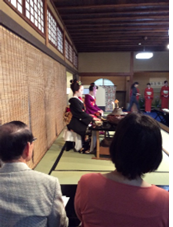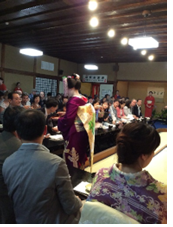Spring in Kyoto, “Miyako Odori” and the modernization of Kyoto 1
Yoshie Doi
 |
 |
 |
| Taken on February 11, 2023 Digital advertisement on subway Karasuma | Gion Kobu Kaburenjo, Miyako Odori, Tea Ceremony
|
It’s almost spring, the season of Miyako Odori. It is held in April every year. With the Meiji Restoration, Edo became the capital, and the residents of the Kyoto Imperial Palace and the imperial family moved to Tokyo. Exhibition was held at Nishi Honganji Temple.
It was held for 33 days from October 10th. The number of visitors was 11,211, the entrance fee revenue was 731 ryo (300 million yen), and the net profit was 266 ryo (100 million yen). In order to make it both amusement and entertainment, “Miyako Odori” was performed on the stage of Matsunoya in Gion Shinchi Shinbashi. This is the first Miyako Odori. 224 geisha and maiko from Gion performed Kyoto dance.
It was performed five times from 5:00 pm to 12:00 pm, and was very popular.
In the following year, in 1873, it was held at the Kaburenjo, a remodeled former Seiju-in Temple sub-temple of Kennin-ji Temple.
At the 13th Miyako Odori in 1882, the stage was a gorgeous stage with lighting up for the stage, the first of its kind in Japan, using Shimadzu technology.
Originally, the dance of geiko and maiko was performed elegantly in a small room. Even now, it is performed in tatami rooms in teahouses and restaurants. The Miyako Odori was a form in which maiko danced side by side in front of a large audience, and was a major turning point for Japanese dance. It was a style devised by Mr. Yachiyo Inoue, the third generation of Kyomai and Inoue, and Mr. Jiroemon Sugiura, the family head of Ichiriki.
I have taken many foreign visitors to Japan on the Miyako Odori and witnessed the spectacle that they were truly moved by. This is because, unlike Western dances, it is a dance that envelops the surrounding air. I remember watching flamenco in Spain and feeling that it was the complete opposite of Japanese dance, a dance that exploded with emotion.
Since 2016, due to earthquake-resistant repair work on the Gion Kobu Kaburenjo, the venue has been moved to Kyoto Art Theater Shunjuza and Minamiza. During construction, I watched it at Kyoto University of Art and Design and Minamiza. The Kaburenjo, which I have been familiar with since I was a child, didn’t feel right at other venues, and due to the structure, the tea ceremony was held in a different way than usual. I was looking forward to the opening of this year’s Kaburenjo.
I would like to extend my heartfelt congratulations on the performance of the Miyako Odori, which will be doing at this spring, at the Gion Kobu Kaburenjo, which has undergone earthquake-resistant repair work.
The end of document
